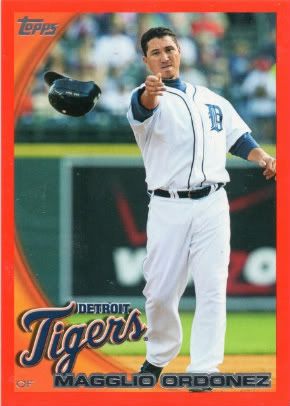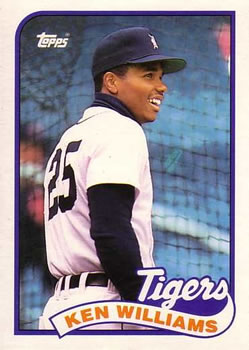The National just wrapped up in Baltimore and I'm now about 36 hours removed from spending the entirety of my Saturday on the convention center floor. That means two nights of sleep for reflection on the good, the bad and the intangibles of the National Sports Collectors Convention.
What's There
If you've been to the National before, you've probably had this feeling: I'm going to go to the biggest card show in the world to do two things: 1. buy some cool cards, and 2. Find Card(s) X that I haven't been able to find anywhere else, which should be easy because this is the biggest card show in the world. See:
Beardy's thoughts on exactly this type of thing.
Well, I can tell you that (1) is incredibly easy to accomplish. There are cards everywhere. So many cards. Some on display, some in boxes you have to pick through, and just about everything that you've ever heard of is at some dealer's table somewhere. But herein lies the paradox of The National, it has, simultaneously, a great selection of cards and a limited selection of cards.
By this I mean, finding any
specific card that you want, while not necessarily a futile effort, will take you so much time, that it almost isn't worth it at all. For example, I knocked off exactly ZERO cards from my "Top 10" wantlist. Yet I was able to get a ton of cards off of more general wantlists (set filler).
The name of the game at the show was Vintage. From the moment you walked in, the old cards where everywhere. I got halfway through the building before I found someone selling any modern stuff. Ultimately I got my modern fix in two places: one dealer who had budget GU and Auto cards (50%-90% "off"), and my favorite, the guy with the 10 for a dollar boxes from the 90s and 00s. At both places, I knew that I was benefiting from buying in quantity and that I could never come close to matching the selection and prices online once shipping was factored in. They were one stop shops. It wasn't until I got home and saw one of Chris Harris' videos that I learned the 10/$1 guy also had serial numbered cards for $0.50. I immediately regretted not spending more time there, as he probably had exactly the type of cards that I was looking for. Still, when you end up with these for thirty cents, and 47 others to go with them...
...Things are ok, indeed.
But back to the Vintage. The problem that I have with vintage is that I don't know what fair value is (I don't look for Vintage singles on eBay), and the ranges for cards seemed ridiculous. Towards the end of my day I focused in on two dealers--one with a 25 card pre-1976 deal, and the other who had his vintage cards in binders--I bought a smattering of cards from the late 50s through the early 70s for between 40% and 60% off...
Pricing
Which is actually something I had to ask about. 40% to 60% off what? Why, Beckett value of course. In the course of my everyday life, I pay exactly no attention to beckett pricing. I don't look at price guides and I don't have an online subscription. I gauge everything on where the card has sold on eBay before, or, if there are no previous sales, where comparable cards have sold, and then I marry that with my thought of how much I would be willing to pay for the card. It is a good system, and it works. But the book prices, I don't know anything about that. It wasn't until I realized that I could get some '59s that looked pretty nice for $2 a pop, or some 60s commons--also in better shape than anything I had in my collection--for $1.50 that I saw the good deal.
As for the big name vintage? Everything
felt overpriced to me. Again, I don't know vintage pricing, when I'm seeing Al Kaline rookies running between $200 and $600, then it is not to be this weekend.
That actually illustrates a dichotomy that I noticed throughout the day. There are two pricing options at the National. Really cheap, or really expensive. There isn't a whole lot in between. That's not to say that prices were unreasonable, but rather that things that you would have to pay a pretty penny for if they showed up on eBay were astronomically priced. Things that you'd usually be able to get relatively cheap--$1-5 inserts or GU on eBay--could be had for very little. Score.
The Value
This is the tricky part. Was going to the National worth my while? The easy answer is yes--I got a bunch of great cards and would go back if it came to Baltimore again. But was it really? Let's break it down.
One Day Ticket: $17.50
That's the out of pocket price for a ticket bought in advance, plus convenience charge. It offers one day of admission. It paid for itself immediately:

That's right. The
moment I walked in the front door, Dmitri Young was in front of me showing off his collection of PSA 10 Rookie Cards. The collection was truly impressive and people were fawning all over the cards blah blah blah. Whatever. That was Dmitri Young aka the only bright spot on the Detroit Tigers from 2002-2005. Sure, I asked him about his cards ("When did you start putting it together?" "Which one is your favorite") but mostly I chatted with him about his Tigers days, including the Opening Day when he hit 3 home runs and is still one of the best baseball memories that I have. "That day still seems like a dream to me." Me too Dmitri, me too. He pulled his PSA10 Al Kaline rookie out of the case to let me look at, because I was a Tigers fan, talked about his time on the Tigers for a few more seconds and then he handed me an autographed poster and I wished him luck on the rest of the show.
Consider the price of admission paid for, thank you very much.
The Time Value of Money
You economists know what I'm talking about. I was at the show from 11-5 give or take, with no breaks. That's six hours on the floor of the show looking for cards. A normal person would think nothing of it, but from the moment I got home my twisted mind was thinking: "Opportunity Cost."
I wasn't going to be working--it was a Saturday and I had had a long week--so no lost wages there. I could have been spending time with my wife (which has a high value) but also probably running errands and cleaning up the house (a low value). Most likely, I would have been relaxing, and perhaps, I don't know, surfing the internet for cards to buy. Bingo. So that's the big question: was my six hours better spent at the National than it would have been at home, looking for cards online?
I say yes.
1. My neck and back paid the price for 6 hours of digging through card boxes, but my eyes would have quit me for doing the same on a computer.
edge: Push
2. I had trouble finding specific cards that I knew I wanted, and was particularly disappointed to find that all of the 2010 A&G minis had been picked through like mad, making a Tigers team set impossible to make. The same goes for other non-vintage sets that I wanted to fill out (Heritage, Topps Gold).
edge: Internet
3. I ended up with plenty of cards that I would not have searched for, or found, online for very little money.
edge: National
4. I was able to fill tons of vintage holes more easily and cheaply than I would have been able to do online.
edge: National
5. I briefly met Sooz and Marie from
A Cardboard Problem, instead of twittering with them and others online.
edge: Internet. Zing! Just kidding ladies. edge: National
6. No shipping costs, no shipping costs, no shipping costs. Even for modern cards, I was willing to inflate what I would pay by $1-2 in order to compensate for not having to pay for shipping, which usually averages $3 on eBay. This made some bargains appear even better, and made other purchases palatable.
edge: National
7. Oh the things you will see. There was so much unbelievably cool stuff there--most of which I will never be able to afford--that had a certain museum quality to it. I mean honestly, some of these dealers can't expect to be able to sell their $50,000 cards. They're just showing off and everybody knows it, which is great for us window shoppers. An added bonus of a show for sure
edge: National
In all, I think the show wins pretty easily. I can't continue to help but feel as though I was missing out on some sort of treasure trove of recent cards that I needed--my really cheap refractors and Topps Golds and modern inserts and A&G minis etc.--I'm sure they were there or, at least scattered throughout a number of dealers. Even so, it is more of an argument for going back a second day than for not going at all. In fact, I'd say you need at least two
hours just to scout the place out.
Over the next few days I'll show off some of what I picked up, including one of the best oddball pieces you'll see. If you're contemplating going to The National in the future, may my thoughts help guide your way. At a minimum, if you're a day trip and GA Ticket away there is no reason not to go.





